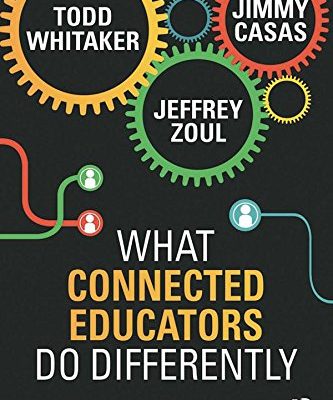“People are always your best resource.”
This is the title of George Couros’ blog post this week. As humans we all appreciate validation and as teachers we certainly want to know that what we do, think and contribute matters. The post is a reminder of the fact that the people who do the day-to-day in the classroom with students are the ones who are tasked with enacting the vision and mission of the school. Why is there often such a disconnect between what we say we do and what’s happening in classrooms? Future forward schools need both things to be connected in order to bring real change. As Couros’ post states, “No mission or vision statement will ever make your school better in isolation. People do that. Focus on people.” Maybe it’s the bubble I’m living in, but I feel like the theme of ‘schools need to change‘ is everywhere I look. If we believe this, then it will take whole school communities to put this into action and make it more than words on paper.
So what does focusing on people look like? How do we take advantage of the resource that is our staff?
Let them lead
In a recent Edutopia article titled “3-Step Method to increase Teacher Voice“, they note that when leaders step aside and facilitate teacher groups to gather input and generate solutions it helps teachers to connect to and be part of the big picture. This way solutions are not placed on the teachers but rather created in conjunction with teachers (and students too when possible!). Plus, offering leadership opportunities for teachers within the school empowers and validates them.
Listen
Schools can learn from other social change initiatives in terms of getting community buy-in.
“In many cases, efforts to engage affected communities take place after leaders have designed and launched data-driven initiatives. But engagement should begin earlier so that community members will have an incentive to support the initiative.” Community Engagement Matters (Now More than Ever)
Get feedback often. Give feedback as teachers. There are so many positive ways to provide feedback. Not all of us are the type to speak out in a staff meeting, but there are other ways to have voices heard. I’ve found that getting together an interested group of staff to work together on something and then presenting our work to the leadership team is an effective and non-threatening way to bring about change. In my role as a tech coordinator I’ve made sure to schedule regular meetings with the leadership team to provide feedback and work together to solve problems.
Celebrate Successes
One thing that we’ve introduced to our staff meetings is a regular ‘Celebrating Success’ time. It is completely voluntary. The aim is to offer time to share and/or show successes from the week. Sometimes a teacher will talk about a lesson that went really well. Sometimes they will share an idea or resource that they tried and how it worked. Sometimes it’s little things like a student who was struggling with something but is making progress. Sometimes it’s just a funny or inspiring student quote. All of this promotes community and values teachers as professionals. It also sparks interest amongst other teachers. Following a sharing session teachers are more likely to say, ‘Hey, can you show me how you did that?’ or to be more receptive when the idea comes up again.
What if your school doesn’t have any of this in place?
Start small. The ‘celebrating success’ time is an easy one to start with and I think it could be powerful for teachers to ask for it rather than it being ‘mandated’ by leadership. If your school environment isn’t ready to listen to teachers, try getting together as a small group to work on a problem and then present the solution or findings to your leadership. In my role I often look for the willing to try things out or test an idea with me. It gives us a bit of evidence then to go forward and talk about bigger changes.
What have you done at your school to increase teacher voice? How has teacher voice impacted change at your school?
This post is part of a teacher blogging project hosted by Tricia Friedman.
Image Credits:
• Mic by Niall Kennedy is licensed under CC0
Featured Image Credit:
• Mic by Niall Kennedy is licensed under CC0












4 Comments
Marcello Mongardi
May 22, 2017 at 12:19Hi Kimberly,
What struck me right away about your post is how you were able to highlight the disconnect that sometimes exists between what we say that we do as a school, and what actually happens in the classroom. Bridging that gap is where the importance of people becomes so important.
I can also relate to your notion that the theme of “schools need to change” is behind every turn. We all know how hard change is, and that is because people find change challenging. So we are with people again.
I am so interested to read some following comments, and perhaps comment again once I have had a chance to really think through your question about how we can increase teacher voice.
techiehouse
June 10, 2017 at 10:05Thanks, Marcello. I’ve really loved reading the May posts. For me the theme of change rang loud and clear throughout all of the posts I read in our group. Maybe because that is so pertinent to me at the moment? Maybe because I’m a change fighter right now in the environment I’m in? I don’t know. We always bring our own context to what we read. I too am keen to hear other’s thoughts or experiences with teacher voice. I’m spending the summer looking at cognitive coaching as a model for our school and I think this just might be the thing I’ve been looking for. More to come!
Roxanne Walker
June 3, 2017 at 12:38Hi Kimberly,
I really connected with your point that ‘not everyone is the type to speak out in meetings.’ Valuing people within an organization means valuing different perspectives, personalities and approaches to ideas. It makes me appreciate the environment I’m in, where there is an emphasis on celebrating successes. I know that not all schools are on the same page, so when you mentioned starting small, that also resonated. It reminds me of a comment that I once heard in “The Power of One,” about how a waterfall starts with a drop.
I feel like the when a school is smaller in numbers, teachers’ voices are heard more easily. As a school increases in population, it becomes more and more challenging to achieve this because there’s more factors that have to be considered. The school I’m at has undergone this transformation from small, intimate school to overwhelmingly large campus from K-12. I do think teacher voice has been heard in the reporting considerations, learning environment needs and technology needs. Heard, but still ongoing!
Thank you for highlighting the value of teachers’ voices within schools.
techiehouse
June 10, 2017 at 10:17Hi Roxanne,
Yes! Smaller schools definitely have luxuries that larger schools don’t in terms of intimacy and comfort level. The larger the school the more the machine mentality has to come in to play sometimes just to make sure things work. I get that, but still believe there needs to be a place for teacher voice in big and small ways. I also wonder if this is easier in a primary school environment? I’ve taken a step into the MYP this year after years in primary to work with grade 6 teachers and I’ve discovered that it’s a completely different animal once you leave primary school. I don’t think my experience is unique. I’m having to rethink my approaches to celebrating success and models of engagement with change seem to work differently too. “But I have a subject to teach” can override engagement with new ideas. So, I’m listening. Learning. Trying to adapt to a new environment and still find ways to push for change. Teacher voice is critical. That buy in and partnership is essential to make change. Thanks for your comment!